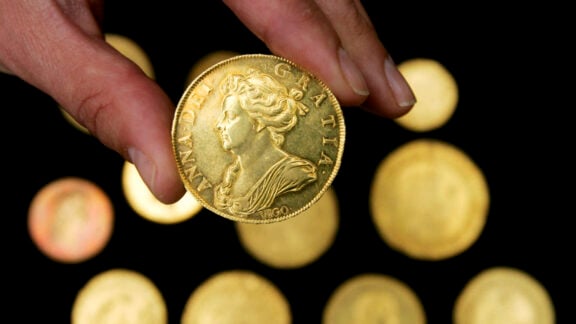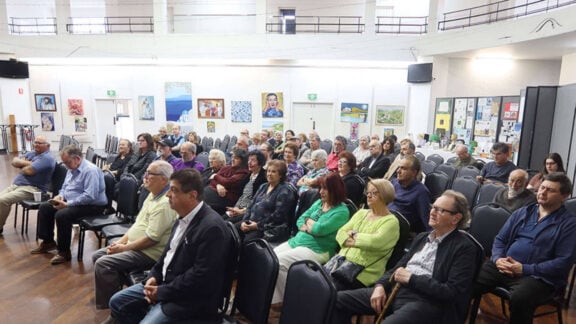In the summer of 1962 on the picturesque island of Hydra, author Charmian Clift embarked on a literary journey delving into her own past to craft her third novel, The End of the Morning.
Immersed in the idyllic setting, she drew from her childhood in Kiama, New South Wales, weaving a narrative through the eyes of Cressida Morley, an adolescent girl.
Clift traded Hydra’s whitewashed walls and Aegean vistas for memories of hot tar, sand dunes, basalt columns, and the complexities of sibling dynamics.
However, as winter cast its chill over Hydra, Clift paused her work on the novel.
Her husband, George Johnston, battling tuberculosis and emphysema, harbored a deep-seated desire to fulfill their shared creative aspirations in Greece which they had once envisioned.
Despite Clift having penned 25 potboiler novels to support their family, Johnston longed to craft one significant work, fearing his own mortality. To support him and give life to his flickering dream she set hers aside. More than 60 years after Johnston finished the iconic My Brother Jack, The End of the Morning is finally being published ahead of the most sacred holiday, Easter.
In the excerpt below provided to Neos Kosmos from her previous book Sneaky Little Revolutions, Clift weaves an ode to Christianity’s most pagan ritual – a passage from darkness into spring – as experienced on her favourite piece of land, Hydra.

The poet George Seferis said that the Easter Passion Week -Greek Easter, that is- was the loftiest form of springtime he knew.
We used to think so too, those years we lived in Greece, where the seasons declare themselves more definitely and more significantly I think, than they do here, and each season has its appointed ritual, so old and so potent with earth-lore that you can understand it in an atavistic way without recourse to Frazer’s Golden Bough, Graves’ Greek Myths, or the liturgy of the Greek Orthodox Church.
May wreath and Midsummer Eve fire, the autumn vintage with its ceremonial toss-potting, the blessing of the waters at Epiphany when shivering young men dive into the winter sea to retrieve a gold cross, the weeks of hectic carnival that precede Lent, Soul Saturdays for the propitiation of spirits, Clean Monday for purification, each has its proper time and purpose, each ceremony is always true to itself, yet mysterious, pulsating with life, and whether it is Demeter or Saint Demetrios, Saint John or Poseidon the Earth-Shaker, Helios the Sun God or Elijah the Prophet, what does it matter?
Christ and Dionysus merge in torn flesh and flowers, and life is resurrected from the dead earth. The pagan world is always there, lingering on, dark and impenitent.
And every year, it did indeed seem miraculous that those austere crags and stony fields could spring again, so suddenly it happened. Overnight rough mountain tracks were starred with clumps of camomile daisies, as though for a bridal way or a triumph, and the slopes were stupefying with wild thyme and spotted with crimson anemones, crinkle-petalled and fine as silk. Red as blood. You could wade in the ragged asphodel. There were little hooded green lilies sprung up between the stones, trails of wild caper blossom drooping fringes and tassels from every crevice, tiny pale violets, narcissus, pink hyacinth, strange delicate trumpets and spikes whose names I never knew, brown bells on acid yellow stalks almost as fine as hair, and flowers so minute in size and simple in form that we called them ‘dolls’ flowers’.
The irregular ploughed patches high above the white town were washed with a green so tender as to be almost transparent, in paved courtyards the hard sticks of pruned vines nubbed with little swellings of bud, ancient figs put out new leaves like tiny green hopeful hands, and the broad spiny plates of prickly pear bloomed with soft fringed magenta flowers.

Even in the long vacuum of Lent you were stirred by this vernal festival preparing itself in leaf and bud and shoot: there was a heady sense of imminence. We whitewashed our houses, inside and outside, with brushes tied to long poles and long hair tied up in kerchiefs. We whitewashed courtyard walls and cisterns and well-heads. Pious ladies already faint and exhausted with fasting scrubbed doorsteps and cobblestones and outlined paving flags with new paint. Their men submitted without complaint to the meagre Lenten dishes they were served at their own tables, and then nicked off down to the waterfront taverns to fill up on something more nourishing. Form had been observed, but working men must eat.
I sometimes think that the observance of form is the key to the strength of the Greek family structure. There are so many rituals and ceremonies through the year that family tensions can be sublimated in the involved preparations necessary to carry off the occasion with the proper flair. Everybody, from grandparents down, knows his or her exclusive duties on these ceremonial occasions; even the very little children wait and watch expectantly for their cues from the adults so they, too, can participate.
In the second last week of Lent, just before the Day of Lazarus, the mountain shepherds came down into the town, wearing their wide flat hats tied with leather thongs beneath their chins and high soft goatskin knee boots. They herded before them the paschal lambs. All that week the waterfront was blobbed and clotted with little lambs, delicate crinkled creatures still awkward on thin legs and with their fleeces dyed rose pink and crimson and yellow and blue, whether to distinguish separate flocks or just to please the children I don’t know. Because the lambs were the children’s responsibility, and as each householder selected the family lamb with weighty deliberation and much haggling the children would take it and tend it up on the slopes all dizzying with herbs and flowers and weave garlands for its throat and deck it with woven leading ropes of brightly coloured wool and the intricate woollen pompoms they had been making for weeks. Children and garlanded lambs and flowers. It was very pastoral and ancient and beautiful, and perhaps the more so in the knowledge that it was a prelude to death.
In the meantime the men made home-made fireworks in preparation for the resurrection, and sometimes blew themselves up. There was often torn flesh before the due date.
The Day of Lazarus, eight days before Easter, was children’s day too. Bands of them went from door to door singing the Lazarus songs and receiving eggs or freshly baked Lazarus bread, which was made in sweet little loaves exquisitely stylised into a formalised body in a winding sheet of intricate folds, with crossed hands and stiff thick legs with crudely indicated toes. The bread tasted delicious but it was also so aesthetically pleasing that we were inclined to prop our own children’s loot of loaves on the shelf above the oven hood, just to look at. Foreigners, no matter how willing, or even eager, apparently can’t pass over into the old ritualistic world quite as easily as all that: sophistication gets in the way.
And then it was Palm Sunday, with its crosses of woven palm fronds and laurel, and a great foretelling of the future. And after that it was really Holy Week, Passion Week, and the emotion began to build with an aching intensity. The women were frantic with final scrubbing and polishing, the making of new clothes, the dyeing of red eggs, and the baking of small sweet pastries twisted into the shapes of flowers, and baskets, and serpents, or pastry cradles with a red egg for the baby’s head, and the huge cartwheel loaves of sesame-scented Easter bread brushed with beaten egg and stamped with the Easter symbols. And every day of Holy Week every bell of every campanile rang for service after service. There was not a church on the island that was not packed with emaciated women, fanatical in this final week of fasting, and almost beside themselves with a mounting sense of tension and excitement. Imminent liberation too, I should think. You couldn’t help admiring their fervour and fortitude, for while they starved the whole island was heavy with the smell of food cooking.
On the night of Maundy Thursday religious ecstasy took over absolutely. Christ was seized and Christ was crucified, to candles and Byzantine chanting and grievous sobbing as the crude cardboard effigy, with a silk cloth about its loins and a wreath of mountain thorns on its head, was brought out on the cross and taken in sad, solemn procession around the church before being placed upright in the centre of the nave. It was accomplished. The women threw themselves to the floor in their grief, wringing their hands and clutching their hair. Children wailed and men covered their eyes. Christ was dying on the cross, now, as Christ would die on the cross this night, and now, forever. You felt very close to the beginnings. It has always been the women who have wept, the women who have mourned, and the women who have sewn the winding sheet. This night they spent shivering on the cold marble of church floors, mourning The King.
But even the men fasted on Good Friday. The haggard women in the churches had been busy since dawn, preparing the funeral biers. Every church had its own, very elaborate and mostly very beautiful. They were roofed with little domes of silver or blue enamel, hung with glittering gauze and white satin, with wreaths of mountain flowers and tinsel bows. One was covered all over with hand-made flowers of white organdy, thousands of them. Another had gauze curtains worked entirely with silver beads. There were candles at each corner, and a carpet before each bier, flanked by tubs of mint and sweet basil and flowers, and flowers wreathed too about the cross, bare now, for the King was to be taken to his tomb.
At nine o’clock in the evening you could hear the chanting. The dark waterfront began to flicker with hundreds of points of candle flame and the bobbing orange glow of lanterns, and within five minutes all the processions from every church had poured down the lanes and mountainsides in lurching streams of fire, with the white biers swaying above like nuptial howdahs borne by invisible elephants. It was mysterious and magnificent and awesome. They moved to the throb of drums and the solemn chant of voices, the deep tones of the men, the strained shrill voices of the women, the high piping of the children. Candlelight flickered on taut, pale, exhausted faces suddenly illuminated out of the dark massing and grouping. Gold blazed high in the darkness above the swaying biers, where tall swinging lanterns burned on tasselled shields and raised crosses. Faces swam out of the crowd, closed eyes, straining throats, mouths stretched wide in agony or ecstasy. And very high, high on the dark shape of the mountain against the stars, a ridge of dancing points of flame. The nuns always brought out their candles to the great rock that overhung the town.
Emotion still held town on Saturday morning. In every lane and doorway the little coloured lambs that the children had loved and tended on the slopes were being ritually slaughtered. Men’s work. Crosses were being smeared above every doorway with the running blood from their throats. That was too much. I could never bring myself to move outside, not until the butchery was over and the streets clean again. But by midday the lambs were on their way to the bakehouses, curled -poor little things- in Easter pots of red earthenware patterned with curious white symbols, and stuffed with rice and liver and cinnamon. The air was thick with the smell of blood and spices and cooking. And imminent joy in the miracle about to happen.
At ten o’clock the night was wild with bells, Agios Christos, Nicholas, the urgent clamour of I-Papandi, the throaty clangour of Stephanos, each of 365 churches out-pealing each other, and the whole population dressed in their gladdest best, and carrying tall white candles decorated with tulle and flowers. Pockets bulging with red eggs and those lethal home-made fireworks.
Outside every church a wooden platform had been set up, decorated with palm leaves. The courtyards were strewn with mountain herbs, trampled into such a smell as would bowl you over. There was scarcely standing room. And after the singing and the chanting, just before midnight, the chandeliers were doused, and all the tall candles. Apart from the little oil lamp that burns perpetually before every high altar it was the darkness of the tomb. We all sighed, on a long sigh of near-hysteria.

This was it. The officiating priest suddenly appeared, holding up a lighted candle, and crying, ‘Come ye and take light from the eternal light!’
There was the wildest surge forward in the darkness, a tumult of gasping, pressing bodies, a sea of upraised hands holding candles. One by one the candles took flame from each other and spread and multiplied, running and jumping up flights of stairs and along cool arched cloisters, while on the palm-wreathed platform the symbolic stone was rolled away, and at exactly midnight an angel cried, ‘He is not here! He is risen!’
Great explosions like cannonfire shook the night and every one, laughing quite wildly, was caught in a great wild bombardment of red eggs and those terrible fireworks. Children went completely out of control and whacked each other with red eggs and hurled fireworks like the very little fiends of hell.
‘Christ is risen!’
‘He is risen indeed!’
The parties went on all night, all the next day, and for many days after. People feasted themselves into a stupor. Life could go on, with marriages and betrothals, with christenings and quarrelling and feuds and nagging and worrying about dowries and crops and where the next meal was coming from. And soon the sun burned the flowers away and the mountains reverted to parched rocks, and spikes and thorns.
But something had been accomplished. It was reassurance. And triumph. Everything would come, this year, and every year, in its appointed season.
Even we, ignorant foreigners that we were, had the strangest feeling that we had helped the year along.
The essay was first published in the April 1969 edition of Pol magazine under the title ‘Greek Easter’. Recently republished in Sneaky Little Revolutions, a selection of Clift essays edited by Nadia Wheatley. Republished on Neos Kosmos as per Jane Novak’s approval.










